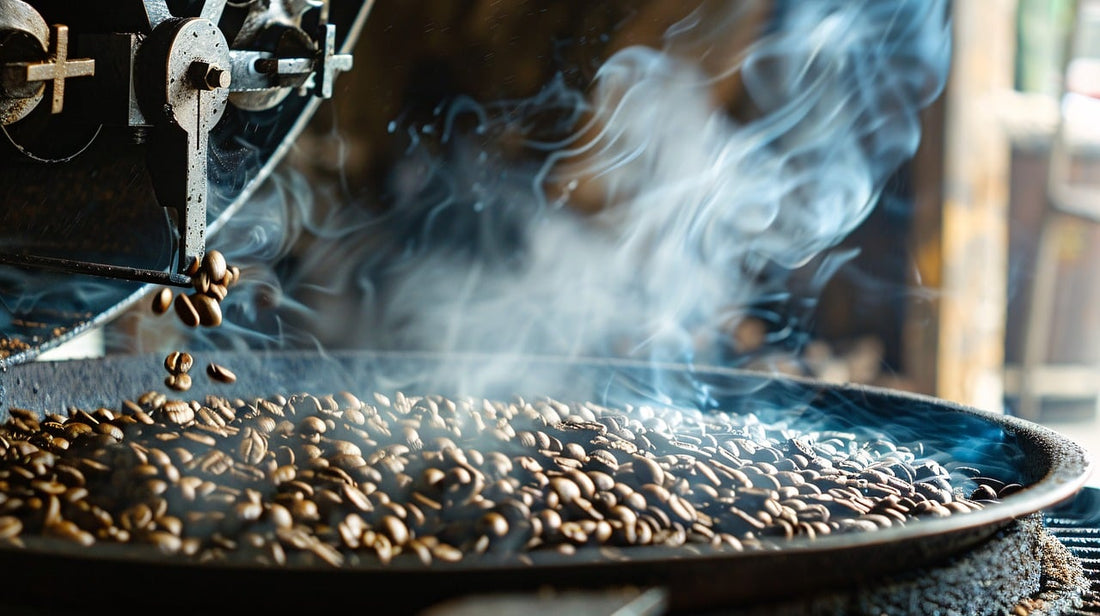
The Coffee Roasting Process Explained: From Green Beans to Brew
Share
The Coffee Roasting Process: From Green Beans to Your Perfect Brew
The coffee roasting process is the transformation of green coffee beans into the flavorful brown beans we grind and brew. This process involves precise heating, timing, temperature control, and airflow, all of which influence the final flavor, aroma, and acidity of the coffee. Here’s a step-by-step breakdown of the coffee roasting process:
1. Preparation: Sourcing and Roasting Setup
- Select Green Coffee Beans: The first step begins with selecting raw, unroasted beans sourced from various coffee-growing regions. Each region’s beans have unique flavor profiles influenced by the climate, soil, and altitude.
- Set Roasting Equipment: Commercial roasters often use drum roasters for large batches, while home roasters may use smaller machines or even an oven to roast coffee beans at home.
2. Drying Stage: Evaporating Moisture
- Duration: 4-8 minutes
- Temperature: Around 300°F (149°C)
- What Happens: Green coffee beans contain moisture. The drying stage gently heats the beans to evaporate this moisture, preparing them for the roasting process.
- Characteristics: The beans begin to turn a light yellow color, and a grassy smell is produced as moisture is released.
3. Browning Stage: The Maillard Reaction
- Duration: 5-8 minutes, depending on the roast level
- Temperature: Between 300°F and 400°F (149°C to 204°C)
- What Happens: The Maillard reaction occurs, where amino acids and sugars in the beans interact to create complex flavors and aromas. The beans begin to turn brown, and the first signs of acidity develop.
- Characteristics: The beans expand, and the smell transitions from grassy to more like roasted coffee.
4. First Crack: Transition to Lighter Roasts
- Temperature: Around 385°F (196°C)
- What Happens: As the beans reach higher temperatures, pressure builds up inside them, causing them to crack or “pop” — known as the first crack. This marks the point where the beans transition into a lighter roast.
- Characteristics: The beans make an audible popping sound, and you'll notice the first hints of roast flavor. At this point, some roasters may stop the process to achieve a light roast.
5. Development Stage: Roasting to Desired Level
- Temperature: Ranges from 400°F to 450°F (204°C to 232°C)
- What Happens: The development stage is where roasters fine-tune the roast by adjusting temperature and airflow to create the desired flavor. As roasting continues, the sweetness increases, acidity becomes more balanced, and bitterness may start to develop.
- Characteristics: The beans darken, and oils may begin to emerge on the surface. For medium roasts, the process may stop here, while dark roasts continue further into the roasting process.
6. Second Crack: Dark Roasts
- Temperature: Around 450°F (232°C) and above
- What Happens: At this stage, the beans undergo a second cracking sound — the second crack. This signals that the beans have reached a darker roast level. The roasting process intensifies, and the beans release oils onto their surface.
- Characteristics: Dark roasts develop bold, smoky flavors and a reduced acidity. Many dark roasts are completed shortly after this stage, creating a coffee with a rich and intense taste.
7. Cooling the Beans: Halting the Roasting Process
- Duration: A few minutes
- What Happens: After the roasting process is complete, the beans must be rapidly cooled to prevent further roasting. This is typically done using air cooling or by stirring the beans on a cooling tray.
- Why It’s Important: Quick cooling prevents over-roasting, ensuring that the beans do not continue to cook and that the desired flavor profile is preserved.
8. Degassing and Resting: Let the Coffee Develop
- What Happens: After roasting, the coffee beans release carbon dioxide (CO₂) in a process called degassing. Allowing the beans to rest for 12-24 hours helps the coffee develop its full range of flavors.
- Storage: Store freshly roasted beans in an airtight container to preserve freshness and prevent oxidation.
Summary: The Coffee Roasting Timeline
The coffee roasting process typically takes 10-15 minutes for lighter roasts and up to 18-20 minutes for darker roasts, depending on the desired flavor profile. Each stage — especially the first crack and second crack — plays a crucial role in shaping the final taste of your coffee. Proper control over time, temperature, and airflow is essential for achieving the ideal flavor balance.
Why Timing and Temperature Matter in Coffee Roasting
The roasting time and temperature you choose affect everything from acidity to body to flavor complexity. Roasting too fast or too slow can lead to undesirable flavors, like excessive bitterness or underdeveloped sweetness. Understanding how each stage of the roast influences the coffee's flavor allows you to create a coffee that matches your personal preferences.
